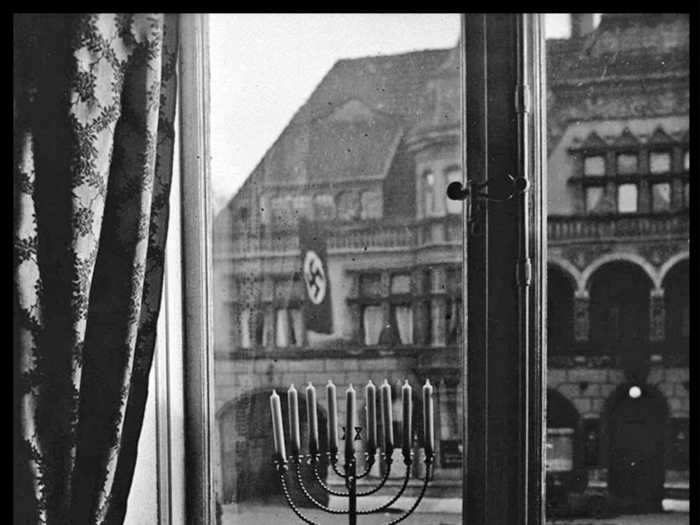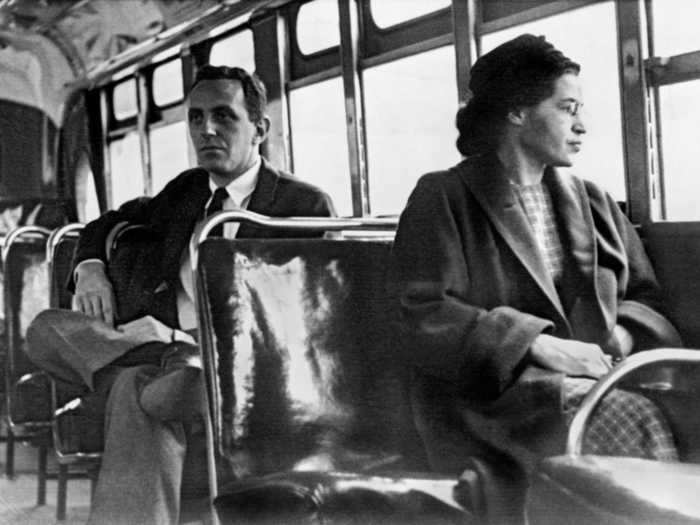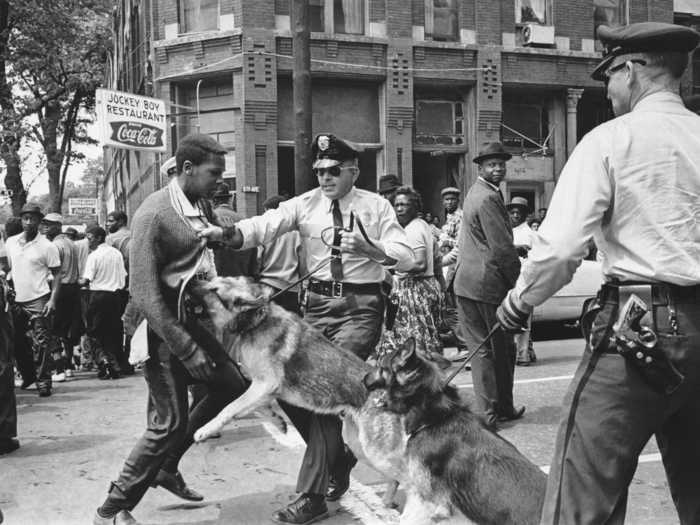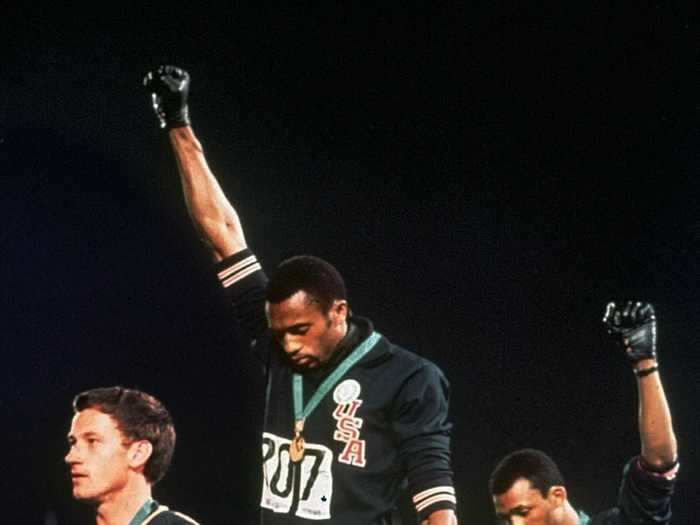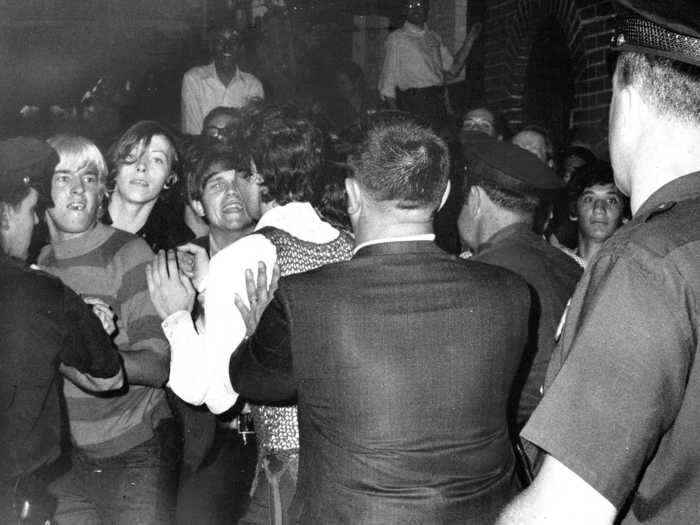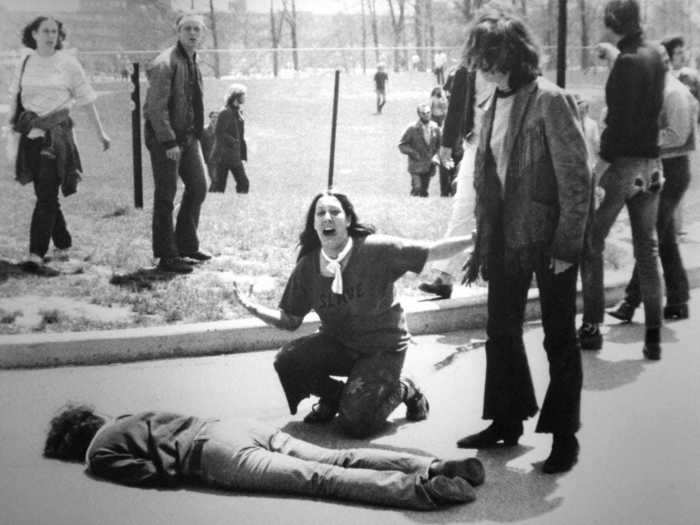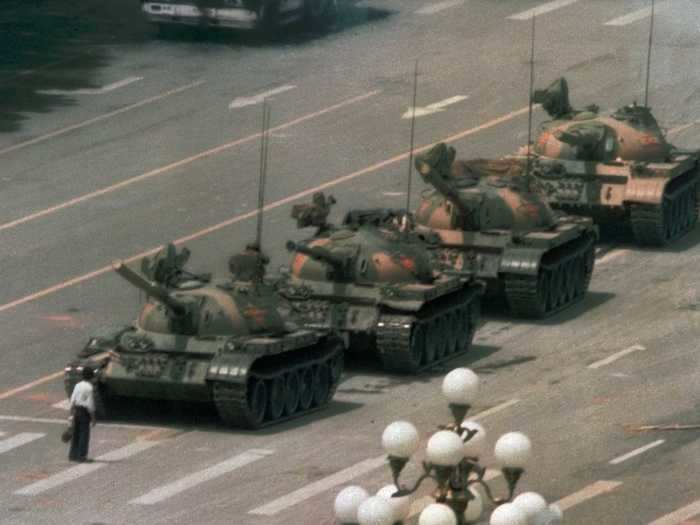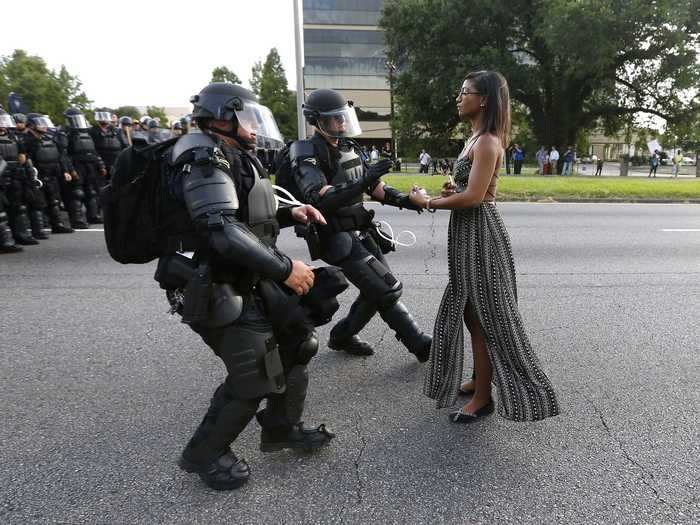A lone man confronts a line of tanks in Tiananmen Square in Beijing, China.AP
- Famous photos of protests and protesters have sparked movements and led to historic change.
- Featured photos include a lone man confronting tanks in Tiananmen Square, a Black Power salute during the 1968 Olympics, and a woman's arrest during Black Lives Matter demonstrations in 2016.
It's not just protests that can make history and lead to lasting change. Photos of protesters standing up for what they believe in can act as powerful symbols, putting a face to a movement and capturing bold moments of resistance.
Here are 10 of the most iconic protest photos in history, presented in chronological order.
One month before Hitler rose to power, a Jewish family living in Germany defiantly displayed a Hanukkah menorah in their window across from a Nazi flag.
1932.
Photo 12/Universal Images Group via Getty Images
The menorah belonged to Rachel and Akiva Posner of Kiel, Germany. Rachel wrote a short poem on the back of the photograph that reads:
"Hannukah 5692 (1932). 'Death to Judah,' so the flag says. 'Judah will live forever,' so the light answers."
The menorah is now on display in Yad Vashem, Israel's Holocaust museum.
This photo of Rosa Parks sitting in the front of a bus was actually taken after the Supreme Court disbanded Montgomery's segregated bus system, but it remains a classic symbol.
December 21, 1956.
Underwood Archives/Getty Images
The white man sitting behind Parks is Nicholas C. Chriss, a journalist who was covering the civil rights movement for United Press International.
"Each anniversary of that day, this photograph is brought out of musty files and used in various publications around the world," Chriss wrote in The Houston Chronicle of the photo, according to the New York Times. "But to this day no one has ever made clear that it was a reporter, I, covering this event and sitting behind Mrs. Parks, not some sullen white segregationist! It was a great scoop for me, but Mrs. Parks had little to say. She seemed to want to savor the event alone."
This photo of a black high school student being attacked by police dogs at a civil rights demonstration made the front page of the New York Times in 1963.
May 3, 1963.
Bill Hudson/AP
A 1963 civil rights protest in Birmingham, Alabama, turned violent when police set their dogs on demonstrators. AL.com reported that the protester in the photo is believed to be Ullman High School student Walter Gadsden, identified by one of his classmates. President John F. Kennedy discussed this photo after it appeared on the front page of the New York Times the next day.
Photojournalist Bernie Boston captured demonstrator George Harris sticking carnations into gun barrels during an antiwar protest at the Pentagon in 1967.
October 22, 1967.
Bernie Boston/The Washington Post via Getty Images
On October 22, 1967, thousands of protesters marched on the Pentagon to demand the end of the Vietnam War. Over 600 people were arrested.
Actor George Harris, known by his stage name Hibiscus, stuck carnations into the barrels of soldiers' guns as part of the demonstration. The iconic image became known as "Flower Power."
At the 1968 Summer Olympics, Tommie Smith and John Carlos staged a protest and displayed a symbol of Black power during their medal ceremony.
October 16, 1968.
AP
US sprinters Tommie Smith and John Carlos were awarded gold and bronze medals respectively at the 1968 Olympics. As the national anthem played during the ceremony, they raised their fists while wearing black gloves in silent protest for the Black Power movement and human rights. They also wore black socks without shoes to symbolize poverty in the Black community, and black beads to represent lynchings.
They were met with racist insults from the crowd, suspended, and kicked out of the Olympic Village. The photo of their act, taken by John Dominis, remains a powerful protest image.
When police raided the Stonewall Inn, a gay bar in New York City's Greenwich Village, it sparked the Stonewall Riots and energized the LGBTQ+ rights movement.
June 28, 1969.
Photo by NY Daily News Archive via Getty Images
The NYPD frequently raided gay bars in the 1960s and arrested patrons for violating laws against same-sex displays of affection. On June 28, 1969, patrons of the Stonewall Inn fought back against the police in what became known as the Stonewall Riots. The uprising led to the formation of groups such as the Gay Liberation Front, Human Rights Campaign, and GLAAD.
John Filo's photo of the aftermath of the Kent State shootings is credited with helping turn public opinion against the Vietnam War.
May, 1, 1970.
John Filo/Valley News-Dispatch
When the US invaded Cambodia in 1970, it sparked student protests at universities across the country. The National Guard was called into Kent State University in Ohio, where the troops fired into the crowd of demonstrators. Four students were killed, and nine were wounded. Student John Filo photographed Mary Ann Vecchi kneeling over Jeffrey Miller, one of the protesters who was fatally shot. Time magazine named the picture one of the 100 most influential images of all time.
Photographer Jeff Widener captured a lone man standing up to a line of tanks in Tiananmen Square in 1989.
June 5, 1989.
AP Photo/Jeff Widener
The day after Chinese soldiers attacked pro-democracy protesters in the Tiananmen Square massacre, a man stood in front of a line of tanks, even climbing on top of one, before he was taken away. The identity of this "Tank Man" is still unknown, but the image remains an iconic reminder of the power of a single individual.
Ceyda Sungur became known as the "Lady in Red" after she was photographed being sprayed with tear gas at an anti-government protest in Turkey.
May 28, 2013.
Osman Orsa/Reuters
What began as a peaceful protest against the government turning Istanbul's Gezi Park into a shopping center turned violent when Turkish riot police sprayed protesters with tear gas in 2013. Sungur's fancy outfit juxtaposed with the police's show of force made this an iconic image and turned her into a symbol of the women at the forefront of anti-government demonstrations in Turkey.
This photo of protester Ieshia Evans' arrest became the defining image of the Black Lives Matter movement in 2016.
July 9, 2016.
Jonathan Bachman/Reuters
"A woman standing calmly, her long dress moving in the breeze, two police officers in full riot gear make their move," Reuters photographer Jonathan Bachman said of capturing this shot from a 2016 Black Lives Matter demonstration in Baton Rouge.
Bachman was in Baton Rouge covering the first protest of his career when he photographed Evans' arrest.
"She had no facial expression at all. She just stood there," Bachman told Reuters. "I knew it was a good frame and it was something that would tell a story. When I came back to my car and I looked at that picture, I knew it would speak volumes about what was going on in that moment right there and over the past few days in Baton Rouge."
He titled the photo "Taking a Stand in Baton Rouge."
